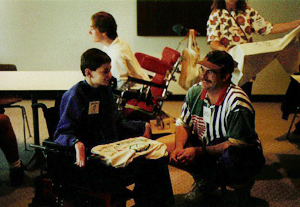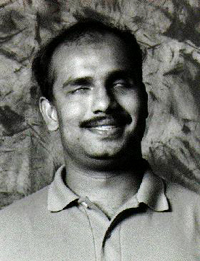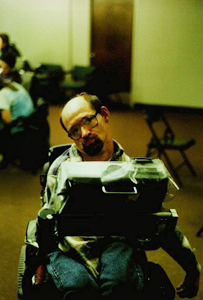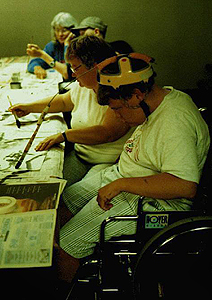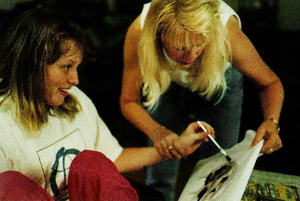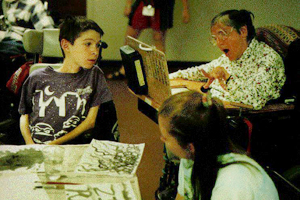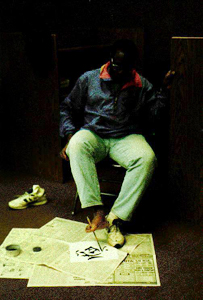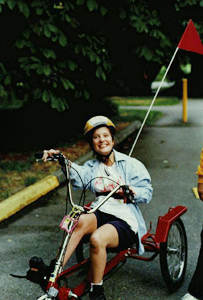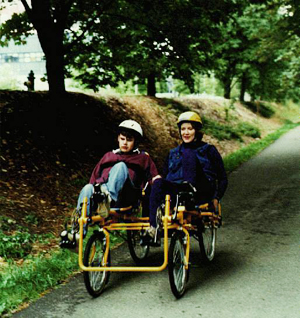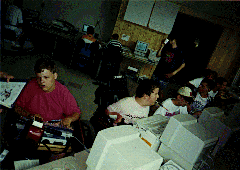Director's Digressions
Recently, I posed some questions on our electronic discussion lists for DO-IT Scholars, Ambassadors, and Mentors about social life in college. Some great ideas emerged. Below I have listed some of the responses, with minor editorial changes. Perhaps you, or someone you know, will find them helpful in preparing for college life.
- Why is it important to have a successful social life in college?
- "As far as social life, I can't stress enough the importance of at least trying to get out and be involved. It really doesn't matter in what; clubs, teams, friends, whatever...It won't be easy, but it's worth it."
- "Social life in college is imperative for your own sanity and for learning how to interact with people. In many cases, people make lasting friendships in college."
- "I found people to be a lot more open in college than in high school, and I learned about socializing with others in college, and am still learning in graduate school. In college, I made most of my friends in classes, in the dining hall, at foreign language table, and at the Lutheran Ministry at my university. I am still in touch with several people I met during my college years."
- "I think I've learned from being with people. I'm not so self-conscious or uncertain of myself. Friends have also reintroduced me to things like crayons and taught me card games and so on. Not only is it fun to hang out with people, but it's emotionally uplifting. Life wouldn't be as worthwhile without friends."
- "I think college consists of both social and academic learning. As I look back on my undergraduate days, I remember a lot more social times with other people than I do lectures or exams. And I'm not really a people person, either. I know I learned a lot from the social end of things. Some of that learning was painful, because when you make friends, people sometimes give feedback which you need but wouldn't otherwise get about behavior and attitude. This is part of people relating to one another, and causes necessary growth. Mostly, though, socializing is fun, and being by yourself is lonely."
- "College teaches you many things if it works right. How to interact with many people in many different ways and on many different levels, but it also gives you information and hopefully enhances problem solving and thinking for yourself skills."
- "...those that come out of college without social interaction will have trouble. We live and work in a world where groups of people solve problems. Especially in the areas of science, math, and engineering. Therefore, these people coming out of college will have trouble succeeding because they do not have the higher social skills required in this situation."
- "In college, one has the challenge of balancing academic demands with social pleasures. That is something that will be important later on, too."
- "I believe that this type of socialization creates professional associations that last. Now that I am a computing professional, these relations continue. We have careers in common and I rely on others to give me important information. My friends also rely on me to feed them information."
- "...in many cases for disabled people, socializing is the key to academics. ...[blind students] need sighted people that are part of the class, in the same section of the book, listening to the same lectures, doing the same homework to help us with them. With their help we can get the descriptions we need. Therefore, socializing is, as I have said, imperative. Academics is the road we use to get there. After academics, or dorm life, we can branch out into wider social circles. It is a progression."
- "Having a successful social life will make your college career easier for many reasons. First, with a social life, a person does not feel lonely because you have friends to talk to and listen to. Second, you can get help from your friends if you need help. For example, you can study those killer midterms with friends! Third, a person would have more chances to form a relationship which we believe is important to people. Fourth, it will make you a 'well rounded' person and most companies will look for that when you look for a job."
- "I have seen people who had a good social life in college and did poorly in college. The key is to balance your social life and college. This is a key skill that you need to learn in college. In your professional career, you need to do this with your career and family."
- What special issues face students with disabilities interested in developing a satisfying social life?
- "I find it's difficult to make friends because people judge me before they know me. You all probably know I'm quite shy, but to people who actually know me, I'm quite the 'hyper hellion'. I think this has a lot to do with my disability, because it just turns in to a label for me to wear. I know it probably sounds like I'm being a weenie, but it's too true. You try to explain your disability, which is part of you, and all you get back is sympathy. The Internet...allows me to escape my label. I guess you get a chance to know a person spiritually first..."
- "In college and 'real' life you need a lot of support to even survive on your own."
- "I think that blind people face the particular challenge of not being able to walk up to someone with whom they would like to talk unless they hear their voice, or the person introduces him- or herself. In the dining hall, for example, I always asked someone to help me find a seat, but that person would not necessarily know the people I liked to sit with, so it was a game of chance. Sometimes, I met new people, sometimes I happened to sit next to good friends, and sometimes I was unable to join in the conversations around me. However, by making friends in certain interest groups and arranging to meet friends for a meal, I was able to keep in touch with the people I cared about."
- "I did find that my disability got in the way of getting friendly with some of the students, but they weren't worth knowing anyway. The others who accepted me as an equal were the ones I stuck with."
- "My social contacts came from communities of shared interest. Pretty much any religious or political interest, extracurricular activity or hobby can work if you use it. For me, the debate team and the foreign language house provided communities where I felt accepted and had a good time."
- What strategies can you use to help create a successful social life in college?
- "You just need to smile at people and look receptive. You should take some time to go to a common place in your dorm and talk to people there."
- "Living in the dorms helped immensely in immersing me in the college social life. Without the contact in the dining halls, my social life would only have been half as good at best."
- "My social life revolves mostly around people on my dorm floor or in the NASA program. I'm in Intervarsity Christian fellowship, too, but I got involved in that through people on my floor this and last year."
- "A lot of my social life surrounded my career goals. I wanted to be a programmer and hung around the computer lab - not exactly beer and pizza, but it was very social. I think I learned more from the other students than from my professors. There was great interaction and sharing of ideas and concepts. ...Oh, I managed to eat pizza and drink beer, but not in the computer lab."
- "...there are many strategies to fulfilling social life in college. A popular way is to join a fraternity or a sorority on campus. Through this, you can get a lot of friends from your house. Another way is to join a club that matches your interests. I prefer this way because it matches your interests with other people. I have a lot of friends by joining a club. The third way, similar to joining a fraternity, is to live in a dorm."
- "Socializing that is connected to your schoolwork is very valuable, too. I made one good friend in college in a class we were taking together. Every week, we got together and worked on the homework together. The best part was that we were able to help each other, so that it was not one-sided. During my first year as a graduate student, I also frequently discussed problem sets with my classmates. This gave me good experience for collaborating with others on research."
- "I understand that for some people making friends is not as easy as it is for others. But if you would treat people in a friendly manner, they are going to treat you the same. Whereas, if you feel yourself so different from others and would not talk to them, then you will find yourself totally out of place. Everyone is the same and different too. This is what is so good about the world."
